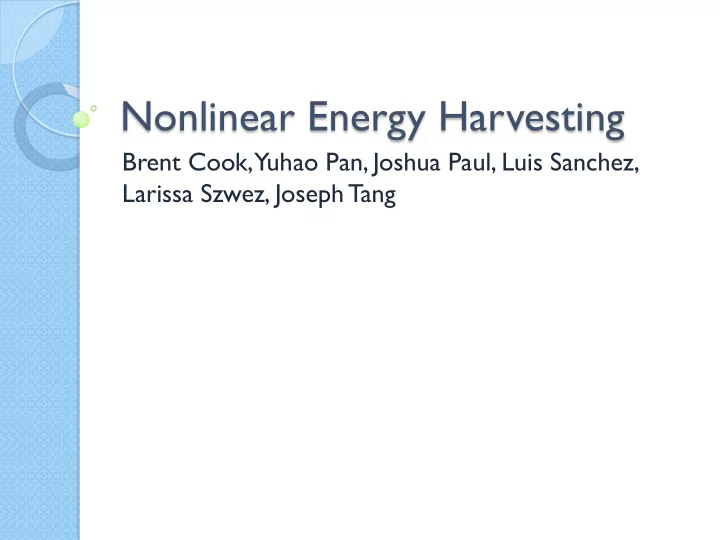

Nonlinear Energy Harvesting Brent Cook, Yuhao Pan, Joshua Paul, Luis Sanchez, Larissa Szwez, Joseph Tang
Our Problem Vibrational energy lost to environment Capturing wasted energy using inverted oscillator Analyze potential energy function to identify optimum physical parameters Helps to predict voltage generation
Potential Applications- Sensors Bus Station Ticket Sensors in Bridges Gates thecityfix.com science.howstuffworks.com
Goals Maximize voltage harvested by the inverted oscillator Derive a model for the voltage produced by the system as a function of physical parameters Find the ideal combination of physical parameters to maximize the energy harvested
Physical Model
Theory: Equation of Motion and Voltage 𝑊̇ 𝑢 = 𝐿 𝑑 𝜒̇ − 𝑊 ( 𝑢 ) 𝑆 𝑀 𝐷
Theory: Deriving Potential Energy
Theory: Deriving Potential Energy (Double Well) ⃗ = 𝑚 ∗ sin φ 𝑦 � 𝑚 � + 𝑚 ∗ cos ( φ ) ∗ 𝑧 ⃗ = 𝑅 𝑚 ∗ sin φ ∗ 𝑦 � + 𝑚 ∗ cos φ − 𝑆 ∗ 𝑧 � ( 𝑚 2 sin 2 φ + 𝑚 ∗ cos φ − 𝑆 2 ) 3 / 2 𝐺 � 𝑚 ⊥ = 𝑚 ∗ cos φ 𝑦 � − 𝑚 ∗ sin ( φ ) ∗ 𝑧 ( φ ) ⃗ ∗ 𝑚 ⊥ 𝑅 ∗ 𝑆 ∗ sin ( 𝑚 2 + 𝑆 2 − 2𝑚𝑆𝑚𝑚𝑡 ( φ )) 3 / 2 𝐺 ⊥ = 𝐺 = | 𝑚 ⊥ | 𝐺 𝑢𝑢𝑢𝑢𝑢 = 𝐺 ⊥ − 𝐿 ∗ φ 𝐺 𝑢𝑢𝑢𝑢𝑢 = −𝑒𝑉 𝑢𝑢𝑢𝑢𝑢 𝑒φ
Theory: Deriving Potential Energy (Double Well)
Theory: Deriving Potential Function (Triple Well) ⃗ = 𝑅 ( 𝑚 ∗ sin φ + 𝑇 ) ∗ 𝑦 � + 𝑚 ∗ cos φ − 𝑆 ∗ 𝑧 � 𝐺 ( 𝑚 ∗ 𝑡𝑡𝑡 φ + 𝑇 2 + 𝑚 ∗ cos φ − 𝑆 2 ) 3 / 2 2 + 𝑅 ( 𝑚 ∗ sin φ − 𝑇 ) ∗ 𝑦 � + 𝑚 ∗ cos φ − 𝑆 ∗ 𝑧 � ( 𝑚 ∗ 𝑡𝑡𝑡 φ − 𝑇 2 + 𝑚 ∗ cos φ − 𝑆 2 ) 3 / 2 2 ⃗ ∗ 𝑚 ⊥ 𝐺 ⊥ = 𝐺 � 𝑚 ⊥ 𝑅 � ∗ ( 𝑆 ∗ sin φ +S ∗ cos( 𝜒 )) 2 = ( 𝑚 2 + 𝑆 2 + 𝑇 2 − 2𝑚 ( 𝑆 ∗ 𝑚𝑚𝑡 φ + 𝑇 ∗ 𝑡𝑡𝑡 φ )) 3 / 2 𝑅 � ∗ ( 𝑆 ∗ sin φ − S ∗ cos( 𝜒 )) 2 ( 𝑚 2 + 𝑆 2 + 𝑇 2 − 2𝑚 ( 𝑆 ∗ 𝑚𝑚𝑡 φ − 𝑇 ∗ 𝑡𝑡𝑡 φ )) 3 / 2 + 𝐺 𝑢𝑢𝑢𝑢𝑢 = 𝐺 ⊥ − 𝐿 ∗ φ 𝐺 𝑢𝑢𝑢𝑢𝑢 = −𝑒𝑉 𝑢𝑢𝑢𝑢𝑢 𝑒φ
Theory: Deriving Potential Function (Triple Well) 𝑅 � ∗ ( 𝑆 ∗ sin φ +S ∗ cos( 𝜒 )) 2 𝐺 φ = −𝐿φ + ( 𝑚 2 + 𝑆 2 + 𝑇 2 − 2𝑚 ( 𝑆 ∗ 𝑚𝑚𝑡 φ + 𝑇 ∗ 𝑡𝑡𝑡 φ )) 3 / 2 𝑅 � ∗ ( 𝑆 ∗ sin φ − S ∗ cos( 𝜒 )) 2 ( 𝑚 2 + 𝑆 2 + 𝑇 2 − 2𝑚 ( 𝑆 ∗ 𝑚𝑚𝑡 φ − 𝑇 ∗ 𝑡𝑡𝑡 φ )) 3 / 2 + Q � 𝑉 φ = 𝐿 2 2 φ 2 + 𝑚 2 + 𝑆 2 + 𝑇 2 + 2𝑚 ( −𝑆 ∗ cos φ + 𝑇 ∗ sin φ ) l ∗ Q � 2 + 𝑚 2 + 𝑆 2 + 𝑇 2 + 2𝑚 ( −𝑆 ∗ cos φ − 𝑇 ∗ sin φ ) l ∗
Calculating Voltage Voltage varies like an AC current 2 ) 𝑜 ( ∑ 𝑊 ( 𝑜 ) V rms = 1 𝑜 2 Self-Averaging
Methodology Plot the surfaces with both varying and constant force applied Derive a way to find, for a given Δ , the Q that maximizes the V rms Find the pair ( Δ , Q) that results in a global maximum V rms
Single Magnet: Constant Force
Single Magnet: Random force
Double Magnet: Δ = Constant, Constant Force
Double Magnet: Q = Constant, Constant Force
Δ vs Q ideal 𝑉 0 = 𝑉 φ 𝑛𝑛𝑜
Results, Single Magnet : Potentials of Points Along Δ vs. Q ideal
Result, Single Magnet: Along Δ vs. Q ideal Curve Δ (m) Q (T*A*m^3) V rms, ave (V) Standard Deviation 0 0 .0012 .000011552 .007071 .000435 .0044 .00020404 .01414 .003315 .0062 .00029936 .02121 .01067 .0071 .00043506 .02828 .02423 .0082 .00048111 .03535 .04541 .0091 .00052889 .04242 .07541 .0099 .00049762 .04949 .1153 .0108 .00067839 .05657 .1659 .0108 .00064192 .06364 .228 .0114 .0007905 .07 .2942 .0117 .00064062 .07739 .384 .0121 .00078317 .08442 .4829 .0128 .00067265
Results, Single Magnet: Deviating from Δ vs. Q ideal Δ (m) Q (T*A*m^3) V rms (V) Standard Deviation .07 .2942 .0117 .00064062 .07 .2992 .0232 .0051 .07 .2982 .0076 .0005606 .065 .2942 .0019 .00018046 .075 .2942 .0028 .00023107 Vrms(.07, .2942) < Vrms(.07, .2992)
Results, Double Magnets: Varying S Δ = .07 m, Q = .2992 (T*A*m^3) S (m) V rms (V) Standard Deviation 0 .0232 .0051 .0005 .0211 .0041 .001 .0234 .0045 .005 .0109 .00063975 .01 .0049 .00062362 .05 .0013 .00011549
Conclusions The system is self-averaging A single magnet oscillator with a single-well potential produces a greater V rms than single magnet, double-well potential oscillators and no magnet oscillator A relationship between Δ and Q ideal is an approximation There is no ideal set of Δ and Q that will maximize V rms
Future Work Determine the relationship between Δ and Q that maximizes V rms Describe the V rms of double magnet systems in terms of Q, Δ , and S. Alter the stochastic force to better approximate vibrations from walking, driving, wind, etc
Recommend
More recommend